What is Customer Stickiness: How to Measure & Improve it?
Customer stickiness measures how loyal and engaged customers are with the brand. Explore the methods to gauge stickiness and offer strategies to enhance customer retention.

Customer stickiness measures how loyal and engaged customers are with the brand. Explore the methods to gauge stickiness and offer strategies to enhance customer retention.

Retaining existing customers and enhancing their loyalty has become increasingly challenging as consumer preferences rapidly evolve. A staggering 80% of future profits are expected to come from just 20% of a company’s existing customer base. The statistic underscores the critical importance of customer stickiness – the likelihood of customers remaining loyal to a brand or company over an extended period. Failure to prioritize it can lead to a revolving door of customers, eroding profitability.
Let us explore the concept of customer stickiness in depth, delving into its significance, key metrics for measurement and proven strategies to enhance it. Businesses can future-proof their success by mastering the art now!
Customer stickiness refers to the ability of a company to retain customers and keep them coming back for repeat purchases. It refers to customer’s loyalty and attachment to a brand, product, or service. Businesses can understand where they stand in terms of customer retention and the likelihood of them continuing to engage with a business over time.
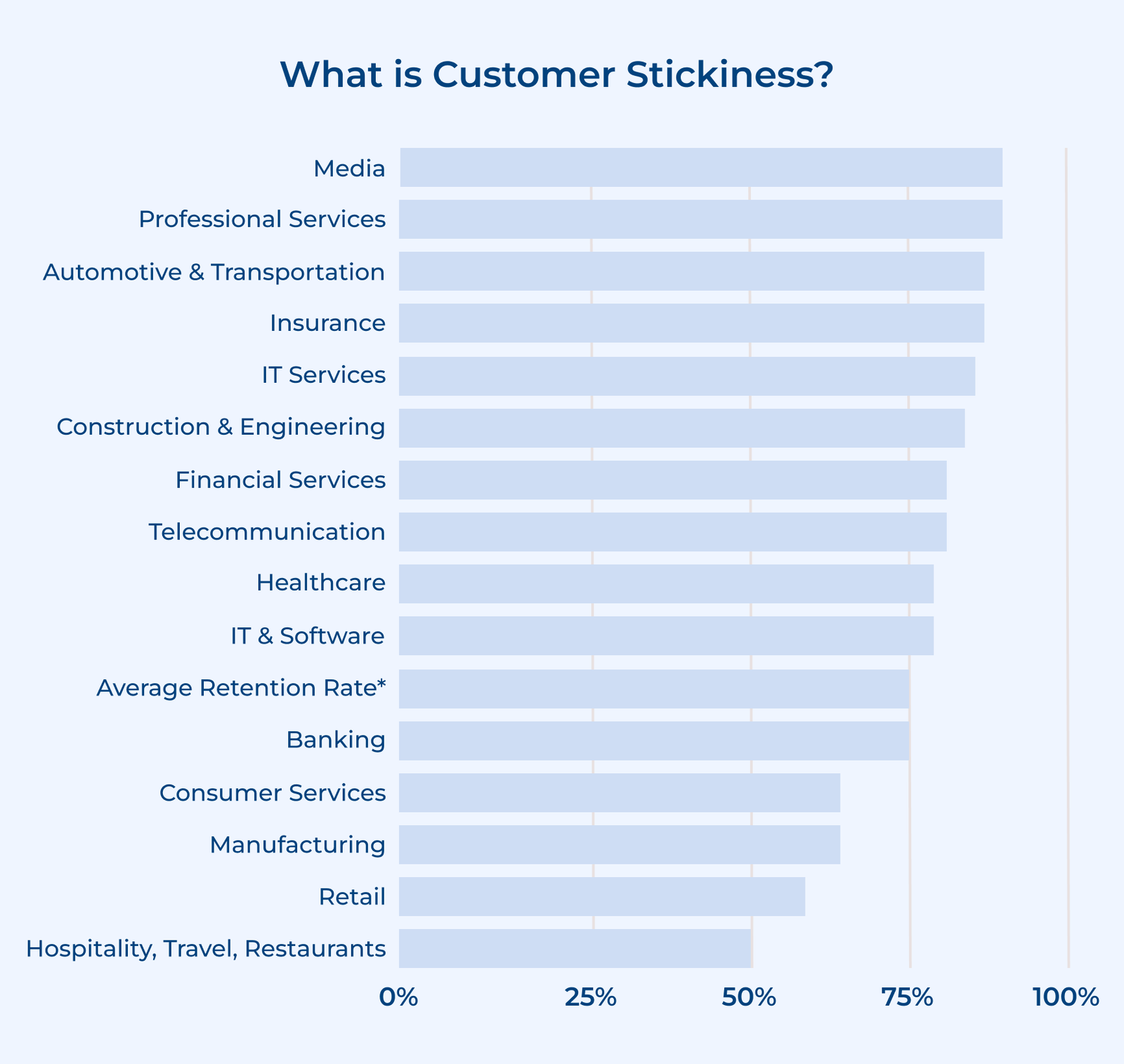
Improving customer stickiness can lead to numerous benefits for businesses, ranging from increased revenue to enhanced brand reputation. Let’s explore them below!
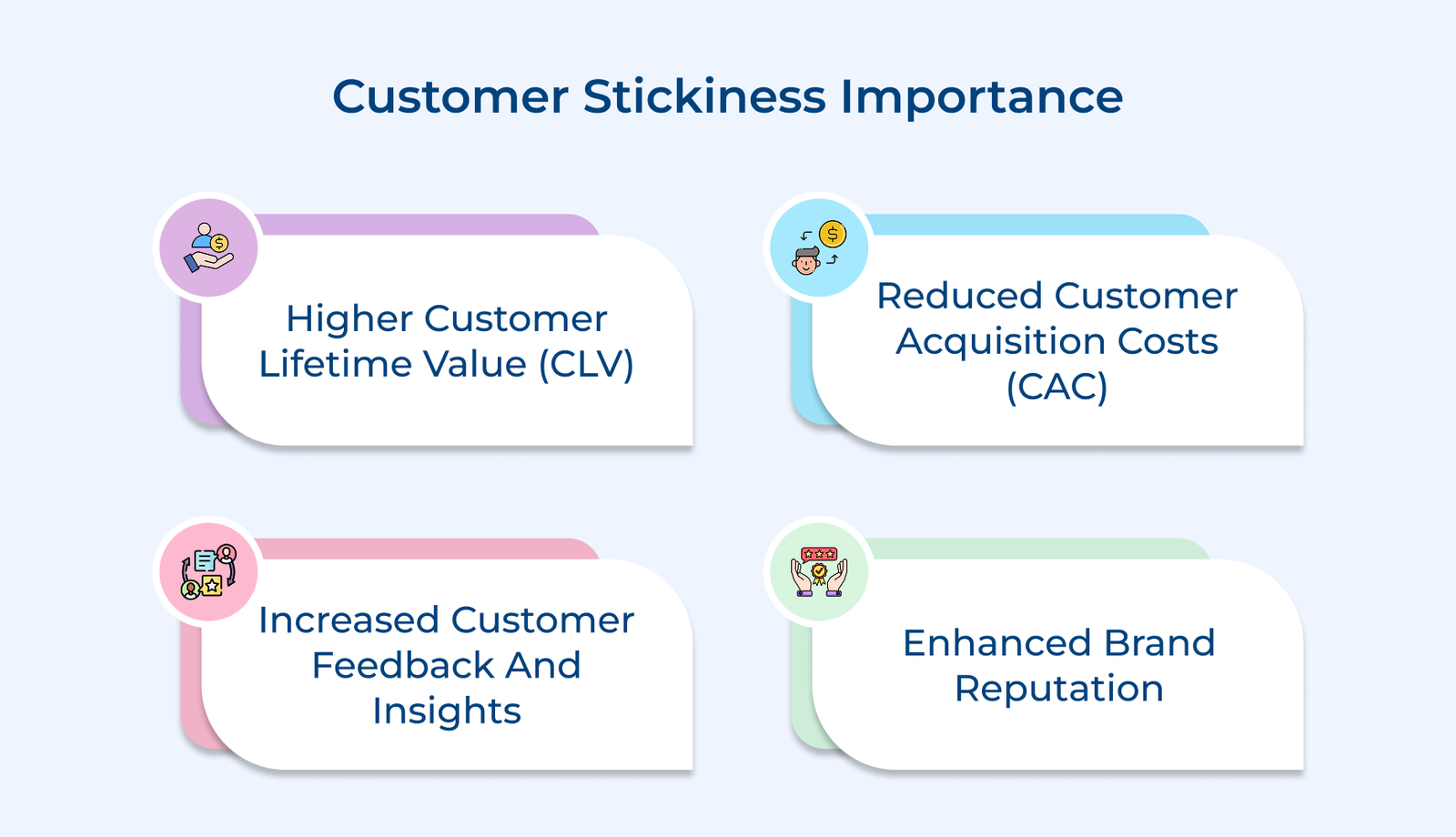
One of the most significant advantages of improving customer stickiness is the increase in Customer Lifetime Value (CLV). CLV represents the total amount of money a customer is expected to spend on the offerings throughout their relationship with the business. Businesses can encourage them to make repeat purchases by keeping customers loyal and engaged, leading to a higher CLV.
Acquiring new customers can be a costly endeavor, often involving expenses such as advertising, marketing and sales efforts. Companies can reduce their Customer Acquisition Costs (CAC) by focusing on improving customer retention. Loyal customers are more likely to recommend the business to friends and family, effectively becoming brand advocates.
Loyal customers are more likely to provide valuable feedback about the products, services and customer experience. They are invested in the brand and want to see it succeed. Businesses can gain a deeper relationship, preferences and pain points by actively listening to customer feedback. The information can be used to make data-driven decisions, improve offerings and address any issues promptly.
Improving customer stickiness can have a significant impact on the brand’s reputation. Satisfied customers are more likely to share positive experiences online and offline. Having a strong base of loyal customers can greatly influence potential buyers where online reviews and social media opinions hold substantial weight. Positive reviews and testimonials serve as social proof, increasing trust in the brand.
Understanding the differences between customer stickiness and customer loyalty is important for developing effective retention strategies.
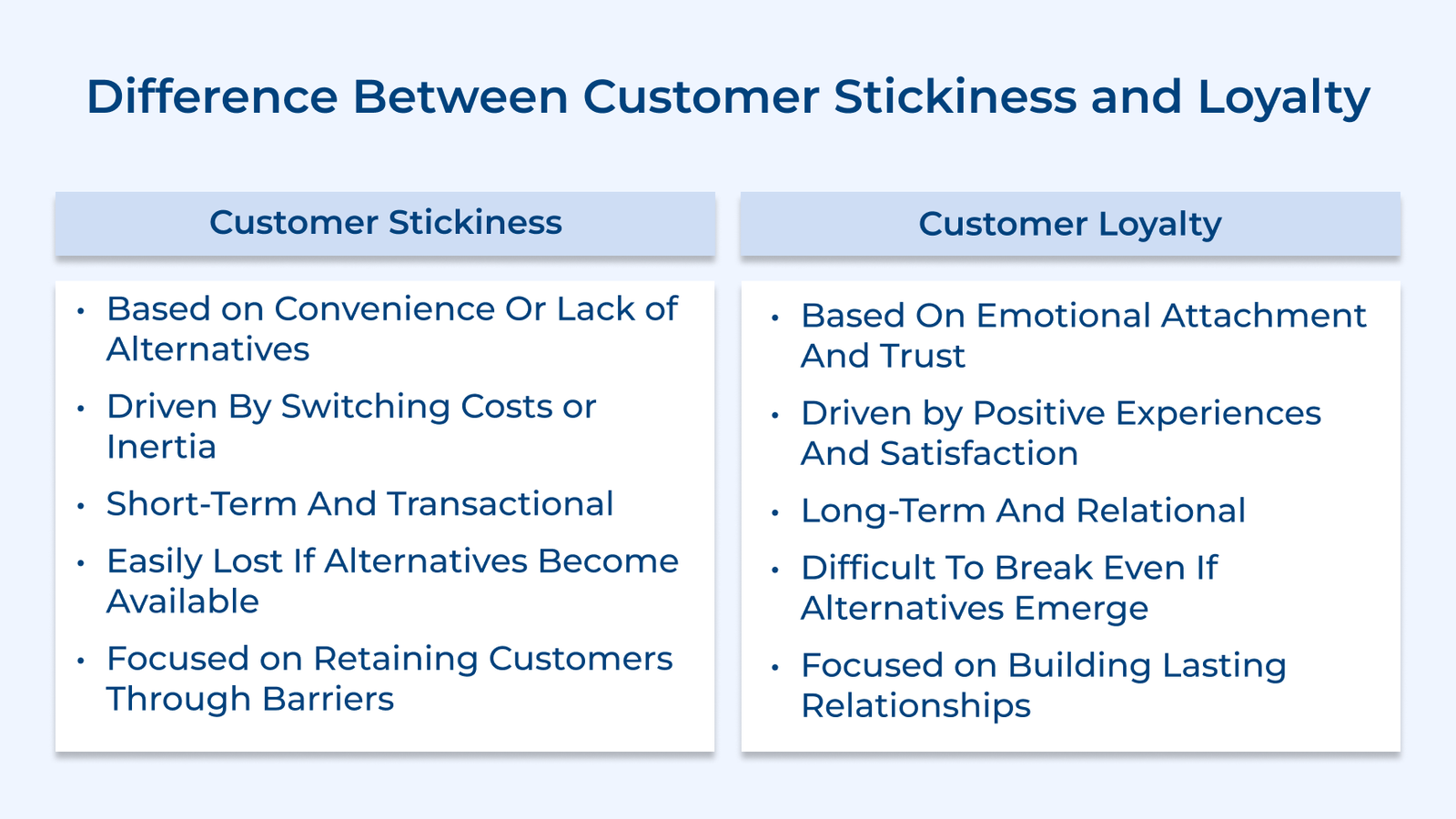
Customer loyalty involves a strong emotional connection between the customer and the brand. Loyal customers have a genuine affinity for the brand and feel a sense of belonging or alignment with its values.
Customer stickiness may not always involve a deep emotional connection. Customers can be sticky due to factors such as convenience, habit, or lack of alternatives, without necessarily having a strong emotional attachment to the brand.
Customers who are loyal are generally proactive in their support of the brand. They actively seek out opportunities to engage with the brand, recommend it to others and provide positive feedback.
Sticky customers tend to be more reactive. They continue to use the brand’s offerings. Their engagement may be more passive and driven by factors like inertia or switching costs.
Loyal customers are often willing to pay a premium for the brand’s products or services. They perceive a higher value in the brand and are less price-sensitive compared to non-loyal customers.
Sticky customers may be more price-sensitive and may switch to alternatives if they find a better deal or if the price becomes too high. Their stickiness is often based on factors other than a willingness to pay a premium.
Loyal customers are strong advocates for the brand. They actively promote the brand to their friends, family and social networks, generating positive word-of-mouth.
Sticky customers may not necessarily be vocal advocates for the brand. While they continue to use the brand’s products or services, they may not go out of their way to promote or recommend it to others.
Customer loyalty implies a long-term, enduring relationship between the customer and the brand. Loyal customers are more likely to stick with the brand over an extended period, even in the face of competition or challenges.
Stickiness can be more short-term or transactional. Sticky customers may continue to use the brand for a while, but their long-term customer loyalty is not guaranteed. They may switch to alternatives if their needs or preferences change.
Below are some of the most effective steps that businesses can take to increase customer stickiness and build lasting relationships with their customers.
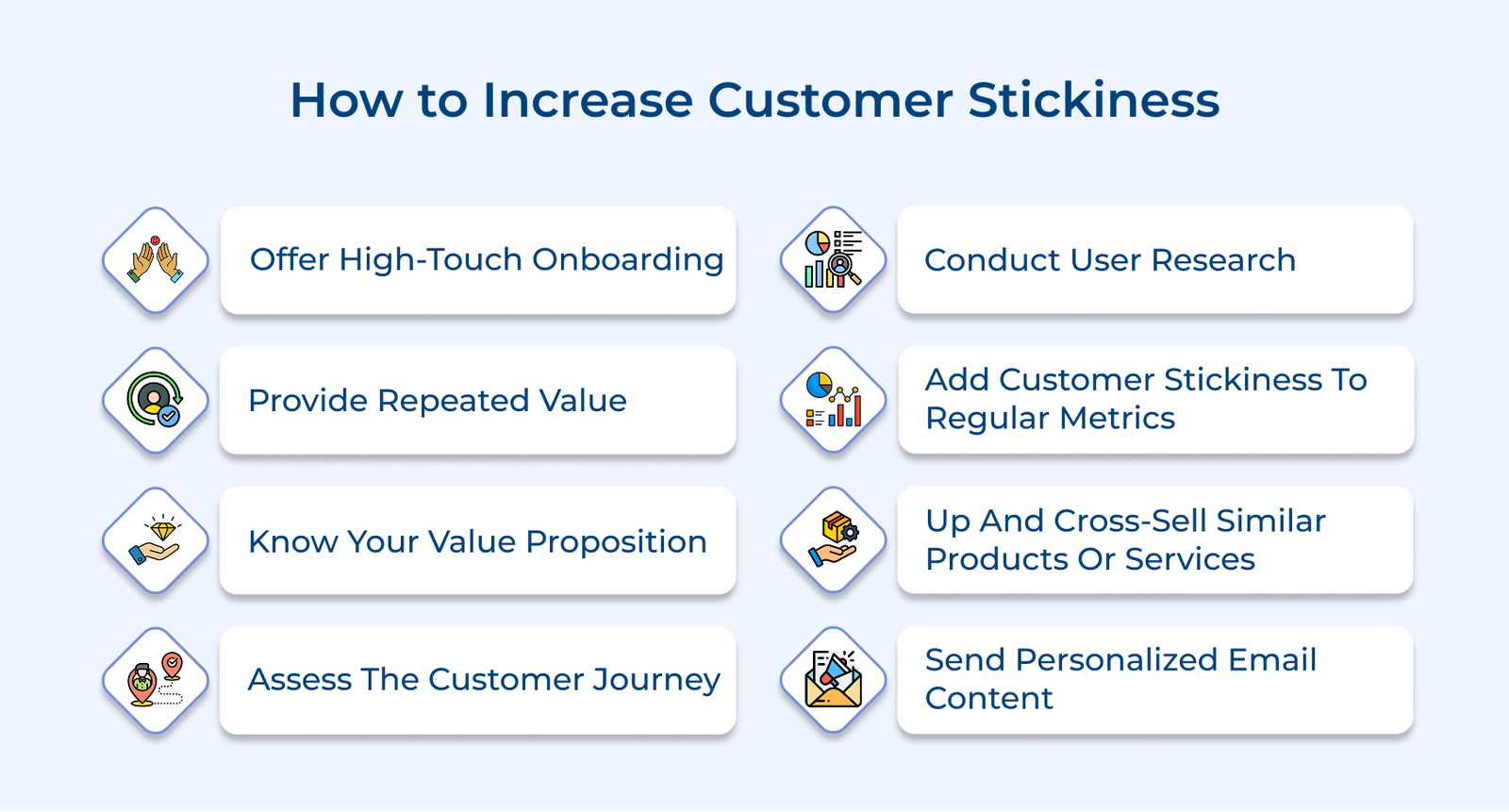
High-touch onboarding is a powerful strategy for increasing customer stickiness and long-term success. Businesses can ensure a smooth transition and enhance a strong sense of loyalty by providing personalized, hands-on guidance during the initial stages of a customer’s journey.
The benefits of high-touch onboarding are numerous. It allows companies to address individual customer needs, answer specific questions and provide tailored solutions. The level of attention helps customers feel valued, leading to increased satisfaction and retention rates. High-touch onboarding enables businesses to resolve potential issues early on, preventing future churn.
How to implement:
Providing repeated value is crucial for increasing customer stickiness and enhancing long-term loyalty. Businesses can demonstrate their ongoing commitment to customer satisfaction by consistently delivering high-quality products, services and experiences. The importance of delivering consistent value cannot be overstated. When customers know they can rely on a company to meet their expectations, they are more likely to remain loyal.
Companies that excel in providing repeated value include Amazon, renowned for its reliable delivery, vast product selection and exceptional customer service. Netflix is another example, consistently offering a wide range of high-quality content and personalized recommendations to keep subscribers engaged.
How to implement:
A value proposition is the unique combination of benefits and features that a company offers to its customers, setting it apart from competitors. Understanding the value proposition is important for increasing customer stickiness. It helps to communicate the core reasons why customers should choose and remain loyal to the brand.
How to implement:
Customer journey mapping is a powerful tool for understanding the various touchpoints and interactions a customer has with the brand. Businesses can identify areas for improvement and ensure that customers remain satisfied by regularly assessing the customer journey.
Implementing regular assessments and making data-driven improvements is crucial for increasing customer stickiness. Continually optimizing the customer journey and addressing pain points can help demonstrate the commitment to customer satisfaction. Regularly review and act upon the insights gained from the assessments to ensure a seamless experience.
Key ways:
User research is a crucial step in increasing customer stickiness, as it provides valuable insights into the customer’s needs, preferences and behaviors. Businesses can gain a deeper understanding of their target audience by conducting user research. It allows them to tailor their products and services to better meet their expectations.
Incorporating user research findings into product and service development is essential for creating offerings that resonate with the customers. Businesses can deliver a more satisfying and engaging experience by addressing their pain points, leading to increased loyalty.
Types of user research methods:
Up-selling involves encouraging customers to purchase a higher-end or upgraded version of a product or service they are already considering. Cross-selling involves suggesting complementary products or services that enhance the customer’s experience. Both strategies can contribute to increasing customer stickiness by providing additional value and convenience.
Let’s assume that a smartphone retailer could up-sell a customer to a newer model. It can include advanced features or cross-sell protective cases or wireless earbuds to complement their purchase.
How to implement:
Personalization in email marketing is crucial for increasing customer stickiness, as it demonstrates that the business values and understands the customer’s individual needs. Businesses can enhance a stronger connection with their audience by sending tailored content, leading to higher engagement and loyalty. Well-personalized emails can increase revenue by up to 5.7 times.
Think of a fashion retailer that could segment its email list based on past purchases and send personalized style guides or exclusive discounts to each segment. A travel company could use dynamic content to showcase destinations or packages that align with each recipient’s interests and browsing history.
Best practices:
Measuring customer stickiness is crucial for businesses as it provides insights into customer retention and the health of the customer base. Here are five key metrics to measure:
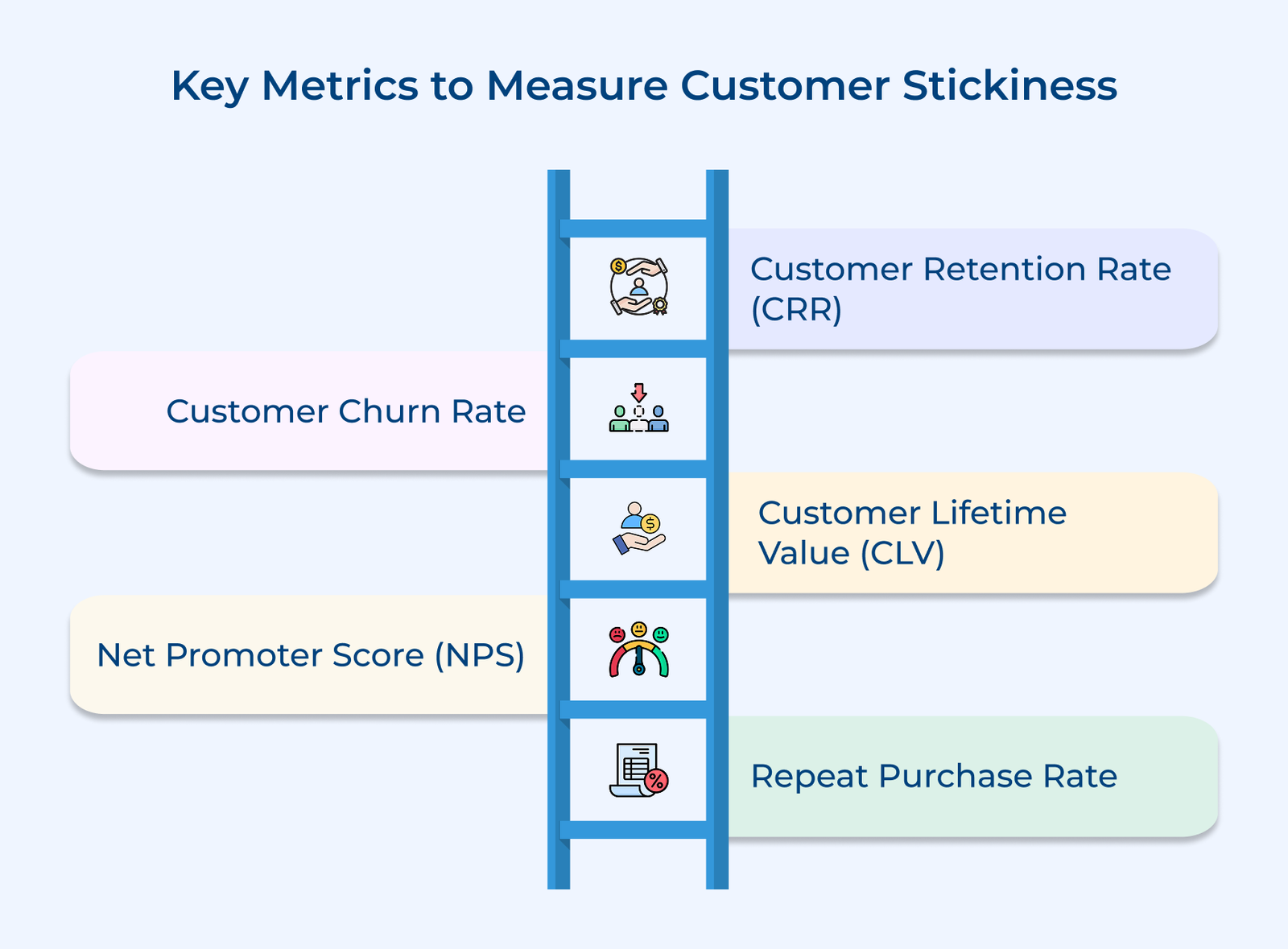
1. Customer Retention Rate (CRR)
The Customer Retention Rate is a fundamental metric that measures the percentage of customers who continue to engage with a business over a specific period. A high CRR indicates that customers are sticking with the brand, while a low CRR may signify issues with customer satisfaction or product/service quality. CRR can be calculated by dividing the number of retained customers by the total number of customers at the beginning of the period.
2. Customer Churn Rate
The customer churn rate is the opposite of the Customer Retention Rate and measures the percentage of customers who have stopped using an offering during a given period. A low churn rate is desirable as it indicates that customers are sticking with the brand. Businesses should aim to minimize churn by identifying and addressing the root causes of customer dissatisfaction.
3. Customer Lifetime Value (CLV)
Customer Lifetime Value is a metric that estimates the total revenue a customer will generate for a business over the entire duration of their relationship with the company. A high CLV indicates that customers are sticking around and continuing to make purchases. A low CLV may suggest issues with customer loyalty or product/service relevance. CLV can be calculated by multiplying the average purchase value by the average purchase frequency and the average customer lifespan.
4. Net Promoter Score (NPS)
The Net Promoter Score is a widely used metric that measures customer loyalty and the likelihood of customers recommending a brand to others. It is based on a single survey question that asks customers to rate their likelihood of recommending the company on a scale of 0 to 10. Customers who score 9 or 10 are considered “promoters,” while those who score 6 or below are “detractors.”
5. Repeat Purchase Rate
The Repeat Purchase Rate measures the percentage of customers who make multiple purchases from a brand over a specific period. A high repeat purchase rate indicates that customers are sticking with the brand and finding value in its products or services. The metric can be calculated by dividing the number of customers who made repeat purchases by the total number of customers during the given period.
Here are five steps that businesses can use to convert their sticky customers into loyal customers.
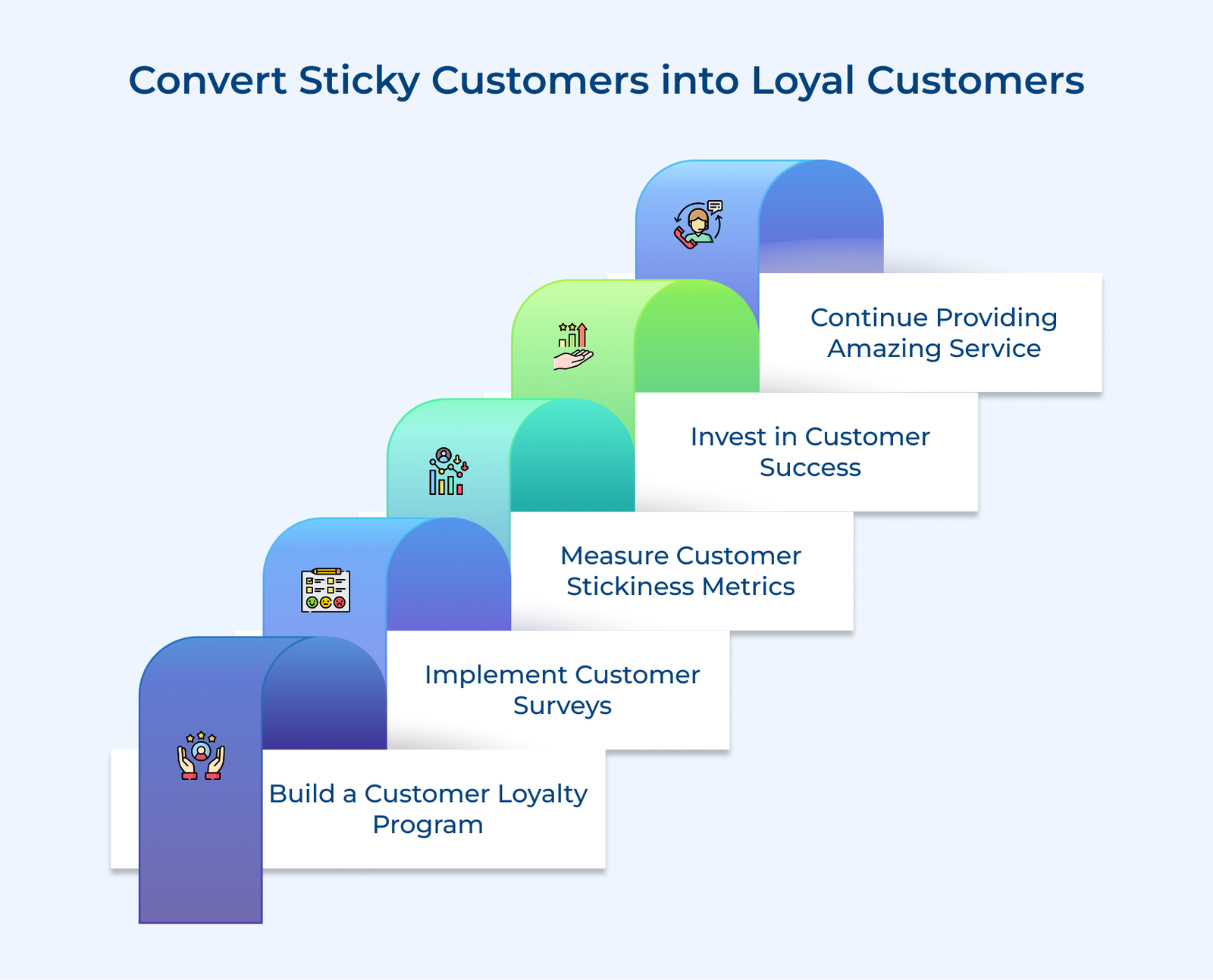
One effective way to convert sticky customers into loyal customers is by implementing a customer loyalty program. The program can reward customers for their continued business, encourage repeat purchases and enhance a sense of loyalty toward the business.
Loyalty programs can take many forms, such as point systems, exclusive discounts, or access to special events. Customers are more likely to become advocates for the brand by showing appreciation for their loyalty.
Customer feedback is invaluable when it comes to understanding the needs and preferences of the customers. Businesses can gain insight into what customers like or dislike about their products or services by implementing customer surveys.
Surveys can also help identify areas for improvement and allow businesses to tailor their offerings to better meet the needs of their customers. Listening to customer feedback and making changes based on their input can help build stronger relationships with their customers.
Net Promoter Score (NPS) is a metric that measures customer loyalty and satisfaction by asking customers how likely they are to recommend the business to others. Businesses can gain a better understanding of their customer base by tracking NPS and other stickiness metrics.
Consistently monitoring the metrics can help businesses identify trends and make data-driven decisions to drive customer loyalty.
Customer success is all about ensuring that customers achieve their desired outcomes when using a product or service. Investing in customer success can help businesses build strong relationships with customers, increase customer satisfaction and drive loyalty.
Customer success can involve providing personalized support, offering resources and proactively addressing any issues that customers may have. Businesses can cultivate loyal customers who are more likely to advocate for the brand by putting the success of the customer first.
The key to converting sticky customers into loyal customers is consistently providing amazing service. Customers who have positive experiences with a business are more likely to return and recommend the business to others.
Businesses can build trust, loyalty and advocacy among their customer base by delivering exceptional service at every touchpoint. Businesses can create experiences that keep customers coming back for more whether it’s through timely responses to queries or going above and beyond to exceed expectations.
Sustaining a robust customer base is vital for the long-term success of any business. Customer stickiness plays a crucial role in achieving the goal of enhancing customer loyalty. Businesses can create a strong bond with their customers by consistently delivering exceptional value, making them less inclined to explore alternatives.
The approach is a testament to the strength of a brand and the quality of its products or services. Businesses can establish a loyal customer base that serves as a foundation for sustainable growth by prioritizing customer satisfaction and continuously adapting to needs.
Customer stickiness refers to the ability of a business to retain customers and keep them coming back for repeat purchases. It is crucial for long-term success as loyal customers not only generate consistent revenue but also serve as brand advocates. Focusing on creating positive customer experiences and providing value can help businesses increase it.
Customer stickiness is crucial for the success of any business. It refers to the ability of a company to retain customers and keep them coming back for more. Businesses can increase profitability, reduce costs and gain a competitive edge by creating a loyal customer base. Prioritizing customer retention leads to long-term success and sustainable growth.
Customer churn, or the loss of customers over time, can be prevented by addressing customer complaints promptly, offering excellent service and continuously innovating. Businesses can reduce churn and increase customer stickiness by focusing on customer satisfaction.
Marketing plays a crucial role in improving customer stickiness by helping businesses attract new customers, engage with existing customers and build brand loyalty. Businesses can strengthen their relationships with customers by developing targeted marketing campaigns, creating compelling content and leveraging digital channels effectively.
Some examples of businesses with high customer stickiness include Apple, Amazon and Starbucks. The companies have built strong brands by providing high-quality products, excellent customer service and personalized experiences. Customers who are loyal to the businesses continue to return for more solutions, driving repeat business and revenue growth.
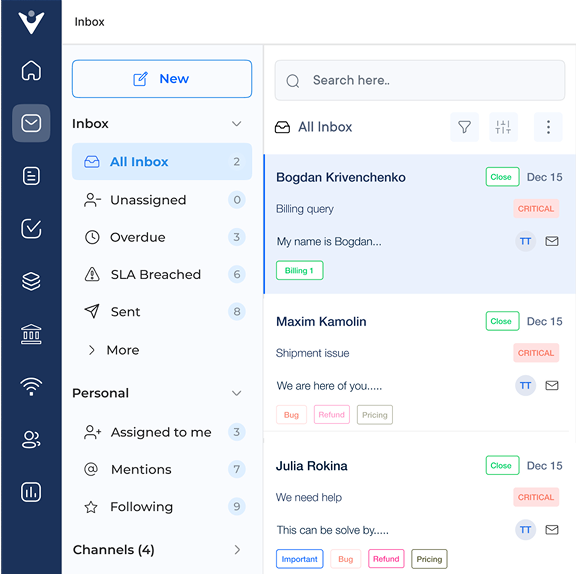
Market better, sell faster and support smarter with Veemo’s Conversation Customer Engagement suite of products.
Unify all your customer data in one platform to deliver contextual responses. Get a 360 degree view of the customer lifecycle without switching tools.
Connect with the tools you love to reduce manual activities and sync your business workflows for a seamless experience.
 https://veemo.io/wp-content/uploads/2024/12/customer-service-response-time.png
1256
2400
Webvision Solution
https://veemo.io/wp-content/uploads/2024/11/veemo.svg
Webvision Solution2025-10-17 10:51:142025-10-17 10:51:149 Effective Tips to Reduce Customer Service Response Time
https://veemo.io/wp-content/uploads/2024/12/customer-service-response-time.png
1256
2400
Webvision Solution
https://veemo.io/wp-content/uploads/2024/11/veemo.svg
Webvision Solution2025-10-17 10:51:142025-10-17 10:51:149 Effective Tips to Reduce Customer Service Response Time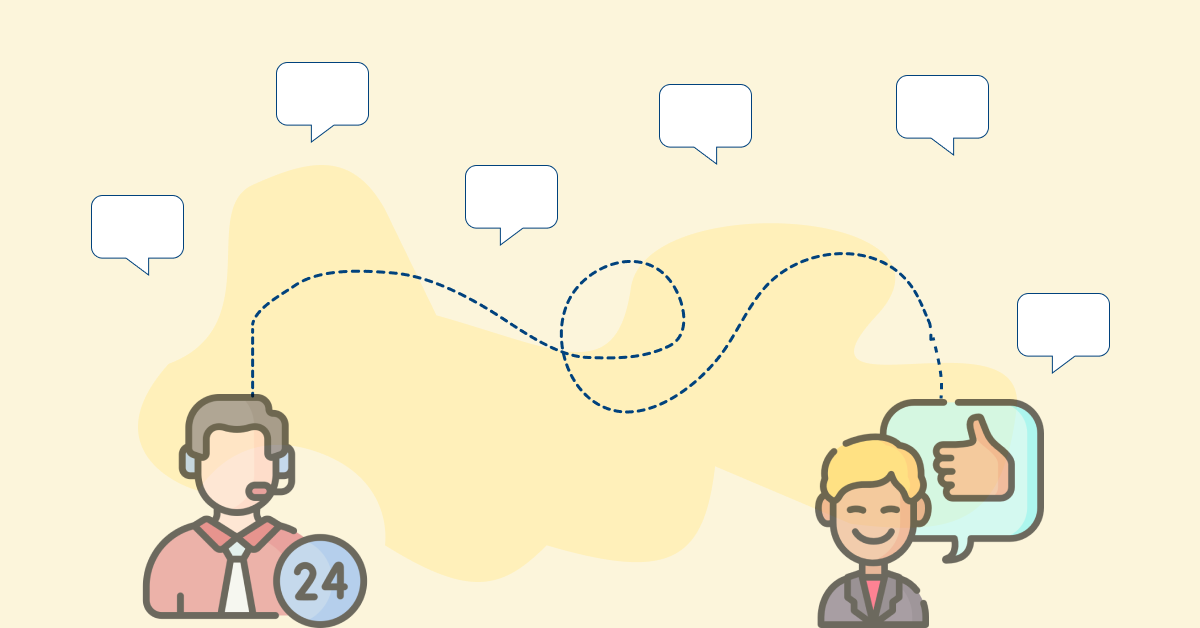 https://veemo.io/wp-content/uploads/2024/06/Customer-Communication-Best-Practices1.png
628
1200
Vikas Sachan
https://veemo.io/wp-content/uploads/2024/11/veemo.svg
Vikas Sachan2024-11-05 06:43:042024-11-05 06:43:04Top 15 Customer Communication Best Practices for Businesses
https://veemo.io/wp-content/uploads/2024/06/Customer-Communication-Best-Practices1.png
628
1200
Vikas Sachan
https://veemo.io/wp-content/uploads/2024/11/veemo.svg
Vikas Sachan2024-11-05 06:43:042024-11-05 06:43:04Top 15 Customer Communication Best Practices for Businesses https://veemo.io/wp-content/uploads/2024/02/Live-Chat-for-Sales.png
628
1200
teamwebvisionsolution@gmail.com
https://veemo.io/wp-content/uploads/2024/11/veemo.svg
teamwebvisionsolution@gmail.com2024-10-21 11:31:222025-08-06 10:22:06How to Use Live Chat for Sales? 7 Proven Ways to Grow Revenue
https://veemo.io/wp-content/uploads/2024/02/Live-Chat-for-Sales.png
628
1200
teamwebvisionsolution@gmail.com
https://veemo.io/wp-content/uploads/2024/11/veemo.svg
teamwebvisionsolution@gmail.com2024-10-21 11:31:222025-08-06 10:22:06How to Use Live Chat for Sales? 7 Proven Ways to Grow RevenueGrow Customer Relationships and stronger team collaboration with our range of products across the Conversational Engagement Suite.

 11 Common Live Chat Mistakes to Avoid for Businesses
Scroll to top
11 Common Live Chat Mistakes to Avoid for Businesses
Scroll to top